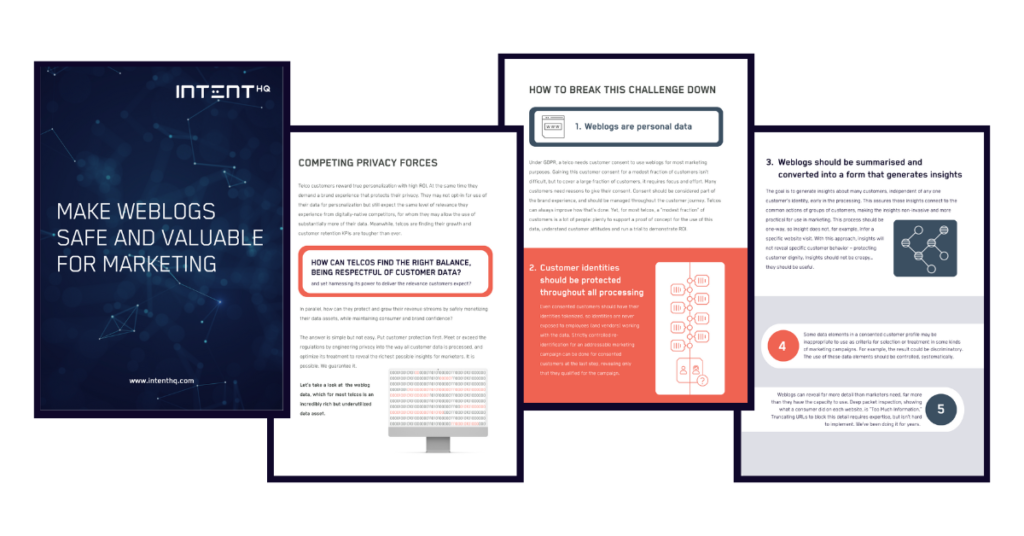Telecommunication companies sometimes veer away from an incredibly rich, yet underutilized dataset – data already in their possession – weblog data. Concerns about privacy, scalability challenges, and fears of potential misuse have created significant hesitation. This has been stopping Communication Service Providers (CSPs) from leveraging their weblogs to offer more relevant marketing and from monetizing this internet traffic data that they already log and analyze routinely for network engineering purposes.
However, privacy/compliance teams at CSPs increasingly believe that the magic formula is to fully figure out the ways to encourage opt-in, while handling weblog data safely, especially for marketing purposes. Senior leadership teams perceive the risks, in general, but are interested in monetizing this valuable asset, without compromise or loss of customer confidence. Simultaneously, the marketing teams don’t know what steps to ask the IT department to implement in order to use weblog data safely.
Privacy-first use of weblogs is possible today, and there is growing interest in proven capabilities that will give early adopters a competitive head-start. To support this shift with technical integrity, Intent HQ has engineered privacy into its digital platform with unique capabilities to unlock the value of weblogs, from the ground up – not added on at the end of processing. The key is privacy by design and, to go a step deeper, privacy by default, which eliminates risk.
What Needs To Be Done?
How can CSPs find the right balance, being respectful of customer data and yet harnessing its power to deliver the relevance customers expect? In parallel, how can they protect and grow their revenue streams by safely monetizing their data assets, while maintaining consumer and brand confidence?
The answer is simple, but not easy. Put customer protection first. Meet or exceed the regulations by engineering privacy into the way all customer data is processed, and optimize its treatment to reveal the richest possible insights for marketers.
Sharing information with data scientists, privacy experts, and IT practitioners has facilitated meaningful conversations about how to overcome the concerns entrenched in CSPs about weblogs. They don’t need to surmount the challenges alone. The following are best practices, observations, learnings and recommendations that we have seen transform the approach to weblog data for CSPs:
- Under GDPR, a telecom needs customer consent to use weblogs for most marketing purposes. Gaining this customer consent for a modest fraction of customers isn’t difficult. This fraction is often more than enough people to support a proof of concept for use of this data.
- Customer identities should be protected throughout all processing. Even consented customers should have their identities tokenized, so identities are never exposed to employees (and vendors) working with the data.
- Weblogs should be summarized and converted into a form that generates insights about many customers, independent of any one customer’s identity, early in the processing. This assures that insights connect to the common actions of groups of customers, making the insights non-invasive and more practical.
- Some data elements in a consented customer profile may be inappropriate to use as criteria for selection or treatment in some kinds of marketing campaigns. For example, the result could be discriminatory. The use of these data elements should be systematically controlled.
- Weblogs can reveal far more detail than marketers need, far more than they have the capacity to use. Deep packet inspection, showing what a consumer did on each website, is “Too Much Information.” Truncating URLs to block this detail requires expertise, but isn’t hard to implement. (Intent HQ has been doing it for years.)
- Consented customers may change their mind and opt out. Systems must support this processing seamlessly.
- Data protection also requires a clear policy for data retention. We recommend 24 months or less for the inferences derived from weblogs.
- Security is the foundation of privacy. Without strong data security, there can be no privacy.
How Do We Scale It?
A big part of the solution to massive weblog data is “data minimization”: select, omit, truncate and summarize. Minimization is great for both customer data privacy and for processing efficiency. In addition, we use software technologies designed for dealing with massive, internet-scale data. We look for opportunities to implement parallel processing, our platform is horizontally scalable in the cloud and has been proven in partnership with the largest telcos in the world.
Our approach to extracting insight grows out of semantic analysis and natural language processing. We use domain-specific AI, machine learning, and related technologies to drive our insights. We’ve been solving problems such as language, ambiguity, correlation, and bias for many years. Intent HQ supports both in-house data science teams and marketing teams. For the in-house data scientists, we generate data features from the weblogs that can significantly improve their own models, such as those that predict churn. For marketing teams, we have created a way for non-technical people to use our insights hands-on: exploring and selecting audiences without exposing personal data. The result can be up to 3x return on investment, monetizing weblogs.
Want to learn more about privacy by design for weblogs? See our free eBook here.
Image credit: Markus Spiske on Unsplash




